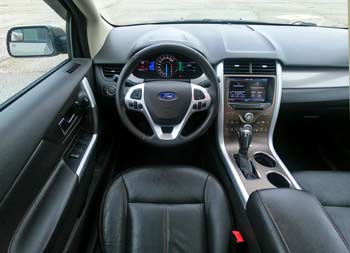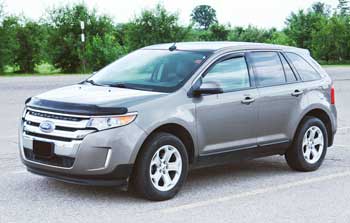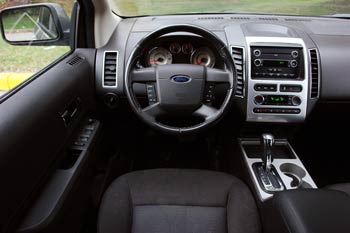Ford Edge 2007-2014: Pros and Cons, Common Problems
By Vlad Samarin Updated: January 12, 2024
The Ford Edge is a mid-size 5-seater SUV. It shares its platform with its luxury twin Lincoln MKX, as well as the Mazda CX-9. The Edge offers a solid feel with sporty handling and a smooth ride. The 2011+ Ford Edge Sport with a 3.7L V6 is one of the quickest SUVs.The interior is roomy with plenty of cargo space. The 2011 facelift brought an upgraded interior and available MyFord Touch with an 8-inch touchscreen.
Pros:
- Distinctive Design: The Ford Edge features a distinctive sporty design.
- Comfortable and Spacious Interior: With ample legroom and comfortable seating, the Edge provides a pleasant driving experience.
- Smooth Ride: The Edge is known for its sporty handling and smooth, comfortable ride.
- V6 Power: The optional V6 offers a lot of power and the extra weight of the engine make the vehicle more stable.
- Generous Cargo Space: The Edge offers a spacious cargo area.
Cons:
- Fuel Efficiency: The Edge's fuel efficiency is lower compared to some other midsize crossover SUVs.
- Technology Limitations: Older models lack some of the advanced technology features found in modern vehicles.
- Expensive Repairs: Potential problems with the transfer case, transmission, as well as a failing water pump in a V6 engine will be costly to repair. The 22-inch tires in the Ford Edge Sport are expensive to replace
- Resale Value: The Edge will experience faster depreciation compared to some rivals.
There are plenty of YouTube videos describing the problem and repair options. This thread at Fordedgeforum.com discusses the issue. Some owners suggest cleaning and lubricating the latch with a spray. One of our friends had this issue with his 2012 Edge and he replaced the driver's door latch ($130 part) that was faulty. A Ford dealer may charge 1.0-2.0 hours of labor plus the cost of part to replace it. Watch these videos on the door latch replacement.
Power steering hose leak: Signs of a power steering fluid leak include a loud buzzing noise from the power steering pump when turning, a lack of steering assist and reddish/brownish oil drops on the driveway.
You can check the power steering fluid level in the power steering fluid bottle on the passenger side of the engine compartment, behind the coolant reservoir. The power steering hose (part) is not too expensive, and your shop may charge you about 2 hours of labor to replace it. Watch these videos on the problem and repair.
Power transfer unit (PTU) failures and leaks have been reported by many owners. PTU is a compact transfer case in the AWD system. It's attached to the transmission and has a few gears inside to angle the rotating torque towards the rear differential. The PTU is filled with a small amount of gear oil and is surrounded by hot exhaust parts. The owner's manual for the 2008 Ford Edge specifies the PTU capacity at 12 ounces (0.35L).
Replacing the PTU will cost over $1,000, as the OEM part alone is priced over $800. Many owners at various forums and on YouTube suggest checking the PTU regularly for leaks and changing the oil in the PTU more often.
Signs of a leak from the PTU include thick black fluid drops in the area to the back of the engine in the middle of the car and a bad smell of burnt gear oil coming from under the car. The PTU doesn't have a drain plug, but according to several owners, the gear oil can be sucked out and changed through the fill plug. There are many YouTube videos on this subject.
Code P0456, purge valve: A failed purge valve can cause the code P0456, however, to confirm it, the EVAP system must be properly tested. Replacing the purge valve (canister purge solenoid) is not very expensive. Watch these videos.
Brake Booster: According to the bulletin 13N02 Ford extended warranty coverage on a brake booster in certain 2010-2013 Ford Edge models to ten years of service or 150,000 miles, whichever occurs first. Check with your Ford dealer if you have any symptoms of a bad brake booster, such as a hard brake pedal or a hissing noise coming from the brake pedal area.
Tie rod ends, control arms: Bad tie rod ends and control arms are not uncommon. That is why we recommend having the vehicle checked out on the hoist in a repair shop at least once a year. Replacing one outer tie rod ends is not too difficult (0.6-0.9 hours of labor for one). Your mechanic may charge you 0.8-1.1 hours to replace one front lower control arm. After the replacement, the wheel alignment must be performed.
Ford issued the TSB 07-21-11 for the Output Shaft Speed (OSS) sensor or Turbine Shaft Speed (TSS) sensor code and/or harsh engagement, no upshift, fifth gear only in the 6F50 transmission of certain 2007-2008 Ford Edge models. The bulletin advises following the diagnostic procedure and if found to be bad, replace the sensor(s). Again, YouTubers made several videos on this problem.
Advertisement
Old spark plugs may cause one of the ignition coils to short, which in turn can cause the PCM to fail. For this reason, it makes sense to replace spark plugs at recommended intervals or earlier. Replacing spark plugs on the V6 Edge will cost 1.5-2.4 hours of labor plus parts.
The Ford TSB 10-21-02 for the 2009-2011 Edge describes a problem with the transmission range (TR) sensor that can cause various transmission problems, such as slipping/neutral out, 5th gear start from stop, electronic PRNDL error, backup camera on in Drive or speed control dropping out intermittently.
The transmission range sensor tells the transmission computer what gear the shifter is in. For example, the backup camera may not work intermittently if the sensor cannot detect that the transmission is in Reverse. The diagnostic procedure in the bulletin involves checking the resistance between the transmission connector pins and if the resistance is out of specs, the transmission range sensor must be replaced.
Ford has issued several recalls for the Edge; check on the NHTSA website.
Summary:
The Edge is sporty and fun to drive, especially with the 3.7L V6. The reliability is not perfect, but not too bad compared to other similar vehicles. We would recommend the later model years with a proven V6 over the 2.0L EcoBoost engine. Avoid high-mileage vehicles. If you can live without AWD, the front-wheel drive V6 Edge will be less expensive to maintain. Crash test ratings are mixed. Check on the NHTSA website. As of January 2024, Consumer Reports rates the 2010 and 2014 Edge as 'average' and the 2011-2013 model years as 'below average' for the reliability.Owner reviews: Many Ford Edge owner reviews are positive, complimenting styling, driving experience, power, MyFord Touch features and safety.
Water Pump in a V6: The V6 is a good engine, but it has one big flaw: the water pump is built inside and is driven by a timing chain. If the water pump fails, it's expensive to replace (about 12 hours of labor) and the coolant might leak into the crankcase. We have seen V6 engines last for over 200K miles, but that's a good reason to avoid high-mileage vehicles.
What to look for when buying a used Ford Edge:
When checking the vehicle at the dealership lot, test all electrical accessories, such as the power tailgate and the air conditioner. Make sure the sunroof opens and closes freely. See if the backup camera (if equipped) works consistently.Earlier, there were many issues with the MyFord Touch system, including the black screen, slow response, freezing, and repeated reboots. Many owners have had the software updated or the APIM module replaced while under warranty. This means, research the MyFord Touch problems and test all the features carefully. See these YouTube videos for more info.
The 22-in tires and rims in the Edge Sport are expensive to replace, check the condition of the tires carefully.
Leaks under the car, as well as the smell of coolant or burnt oil coming from under the hood, indicate a problem. The low coolant level in the expansion bottle might also be an indication of leaking coolant. If coolant leaks from a water pump in a V6, the repair will be expensive. Check the oil on the dipstick and avoid the vehicle if it looks like the coolant is mixed with oil, see how it looks here: how to check the engine when buying a used car.
Several owners mentioned a leaking power steering hose. Before buying a used Ford Edge, have it inspected by a trusted mechanic. Ask to check for leaks and assess the condition of the engine and transmission, a water pump in a V6 and a turbocharger in the 2.0L EcoBoost engine. If possible, the AWD system should be tested to make sure the rear axle receives power.
2007-2014 Ford Edge Engines:
V6 Engine choices: The 2007-2010 Edge comes with a 265-hp 3.5L Duratec 35 V6. For 2011, the 3.5L V6 gained more power (285 horsepower). The 2011-2014 Ford Edge Sport is powered by the 305-hp 3.7L Duratec 37 V6. Both are solid DOHC engines used in many Ford and Lincoln vehicles as well as in some Mazda products.EcoBoost 2.0L: For 2012, the Edge received an optional fuel-efficient 240-hp 2.0L EcoBoost engine with front-wheel drive. It's a gasoline turbocharged direct-injected (GTDI) 4-cylinder motor. You can find it not only in many Ford vehicles but even in some Volvo and Range Rover products. As with any turbo engine, it needs to be maintained well to last.
Read also: Pros and cons of turbo engines. and
Direct Injection: how it works, pros and cons.
Timing belt or timing chain? The 3.5L and 3.7L V6s, as well as the 2.0L EcoBoost have a timing chain. The timing chain doesn't need to be replaced unless it's stretched or there is some other problem with it.
Fuel Economy: The 2012-2014 FWD Edge with the 2.0L EcoBoost engine is the most fuel efficient trim level; the EPA rates it at 21/29 mpg. The 2011-2014 AWD Ford Edge with a 3.5L V6 gets 18/25 mpg city/highway, giving it a range of up to 437 miles (703 km) on a tank of gas. The 2011-2014 AWD Ford Edge Sport with a 3.7L V6 is rated at 17/23 mpg.
How does the Edge AWD system work? All-wheel drive is only available with a V6. It's an on-demand AWD system based on front-wheel drive, which means front wheels are powered at all times. An electronically controlled clutch located in the rear differential engages the rear axle when needed. We didn't try off-roading, but with good winter tires the system works well in the snow.
One of the main components of the AWD system is a small transfer case (power transfer unit or PTU), which is attached to the transmission.
As with any AWD system, it's important to use only tires of the same size, keep the pressure up to the specs and rotate the tires often to make sure they are wearing evenly. The oil in the rear differential and transfer unit must be kept clean.
Related reviews:
Mazda CX-9 2007-2015
Toyota Venza 2009-2015
Honda Pilot 2009-2015
Nissan Pathfinder 2013-2020
Dodge Journey 2009-2019
Ford Edge Maintenance tips: Check the engine oil regularly between oil changes. Keeping the coolant level topped up will help avoid overheating the engine. If you notice signs of leaks on your driveway, have the vehicle checked out as soon as possible to prevent more serious problems. Read also: 12-point Car Maintenance Checklist with Photos.
We recommend having regular inspections in the shop with the car on the hoist done at least once a year to keep it safe. The reason is that many components cannot be inspected in a drive-through quick lube place. For example, a bad ball joint (part of the control arm) is hard to notice unless a mechanic checks it with the car on the hoist.
When bringing your vehicle for service, ask to check the A/C drain; if it's clogged up, water will leak from the HVAC system inside the car. A timely spark plug replacement will help avoid more serious problems like failed ignition coils. Consider rust proofing if you live in an area where salt is used on the roads in winter.
Engine oil capacity: With oil filter change:
2007-2011 Edge 3.5L/3.7L V6 engines: 5.5 quarts (5.2L). The recommended oil grade is SAE 5W-20 Premium Synthetic Blend.
2012-2014 Edge 3.5L/3.7L V6 engines: 6.0 quarts (5.7L). Oil grade: SAE 5W-20 Premium Synthetic Blend
2012-2014 Edge 2.0L 4-cylinder EcoBoost: 5.7 quarts (5.4L). SAE 5W-30 Premium Synthetic Blend is the recommended oil grade.


